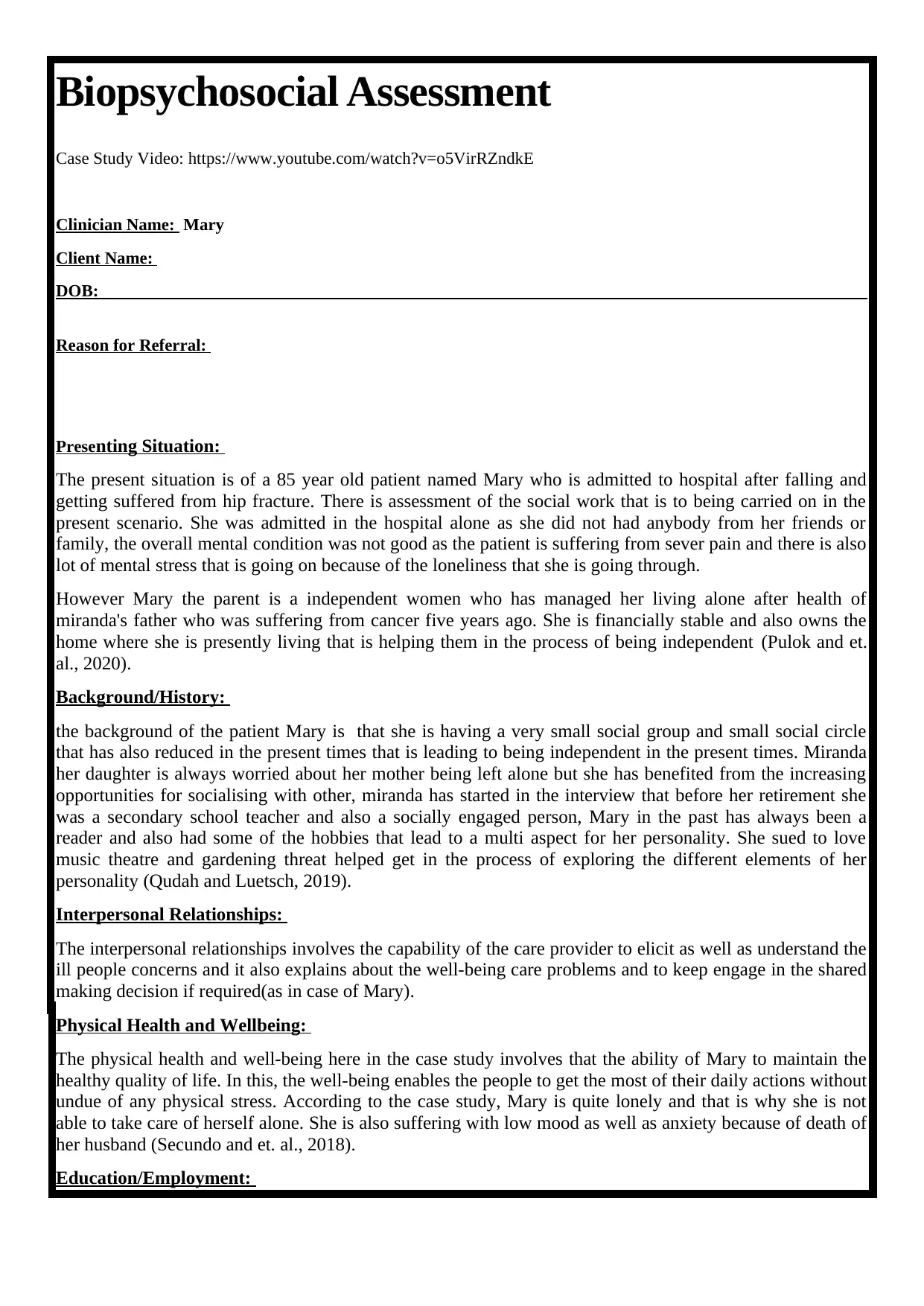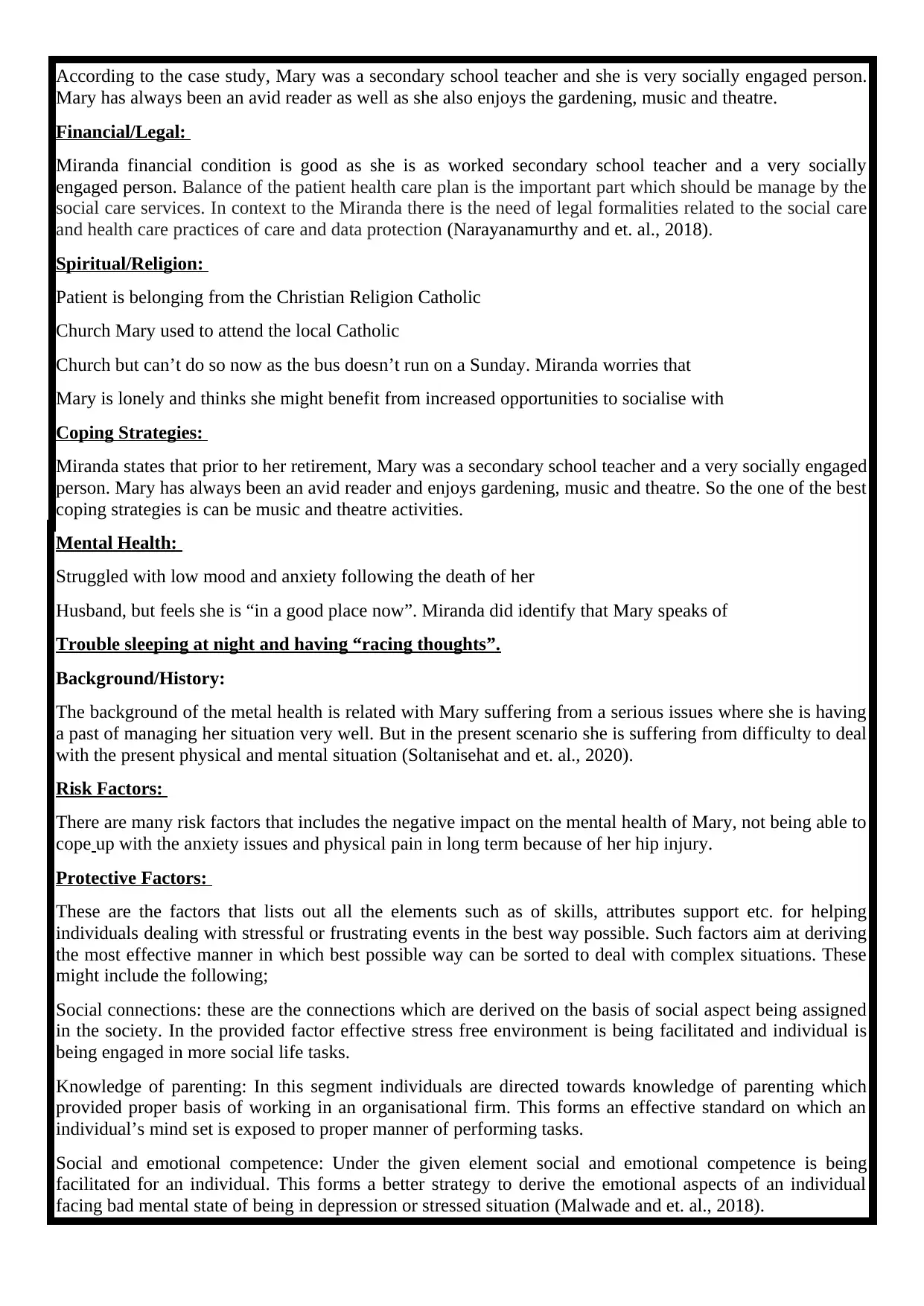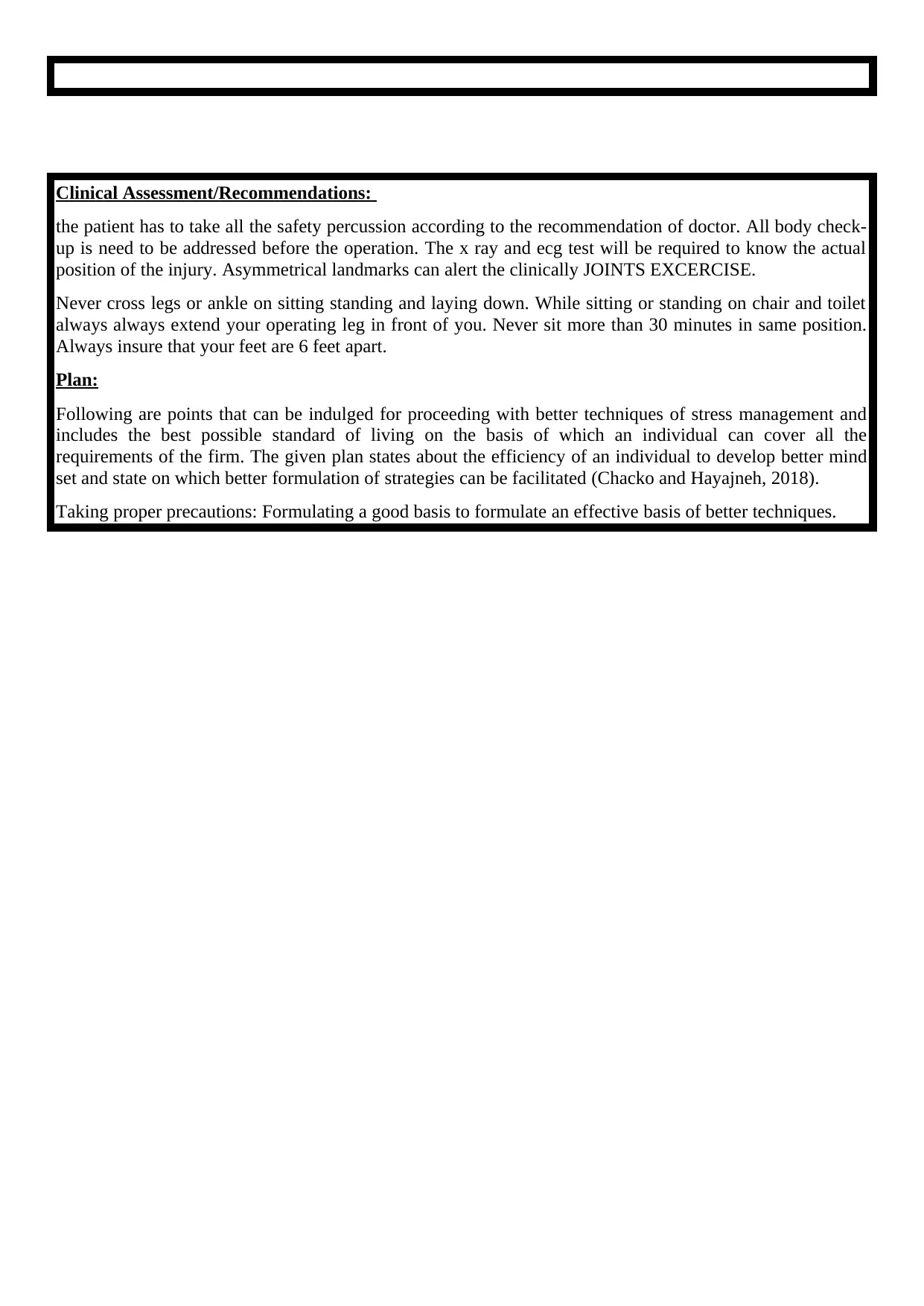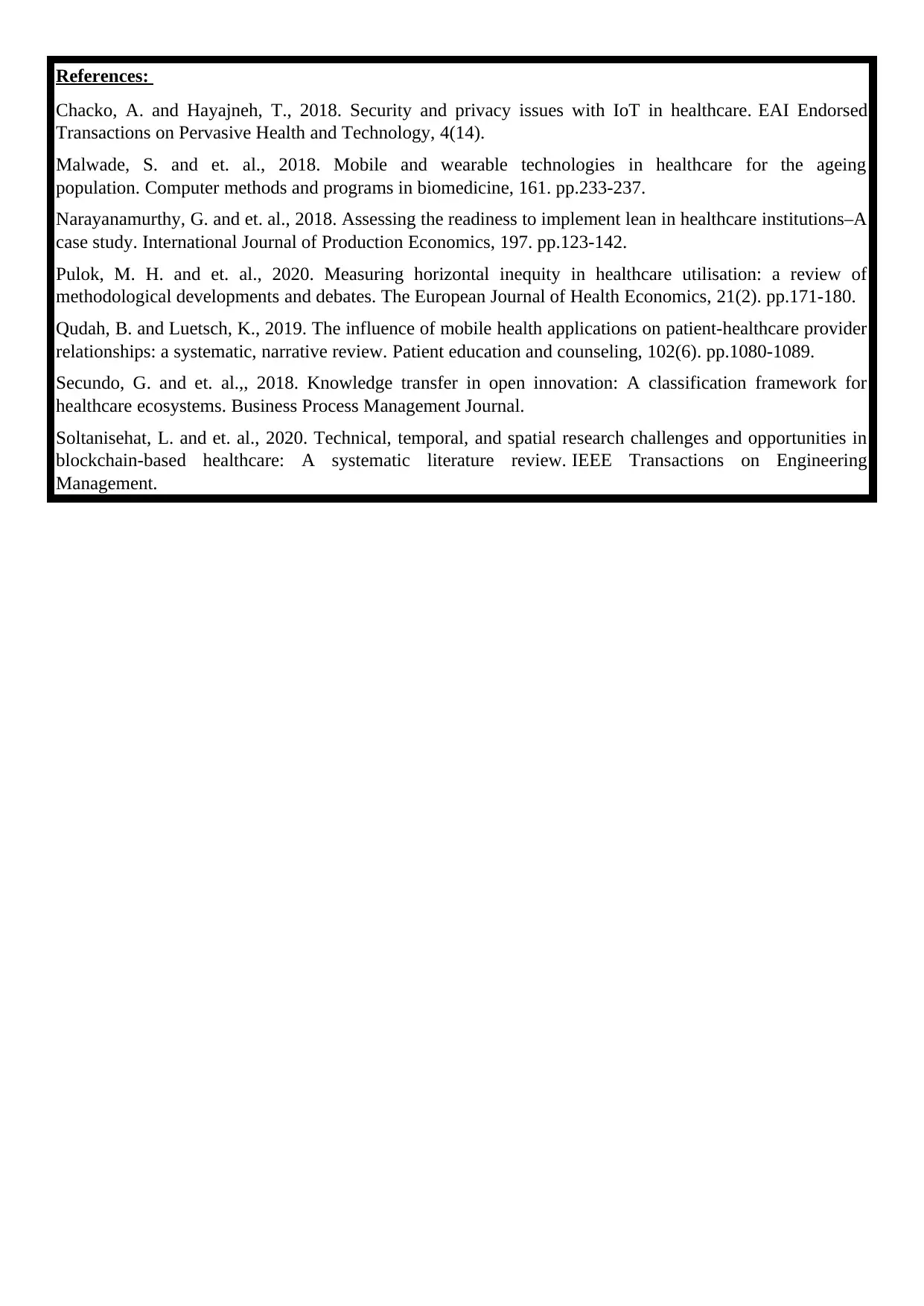In-depth Case Study: Biopsychosocial Assessment of an Elderly Patient
VerifiedAdded on 2023/06/17
|4
|1519
|186
Case Study
AI Summary
This case study presents a biopsychosocial assessment of Mary, an 85-year-old patient admitted to the hospital after a hip fracture. The assessment covers her presenting situation, background, interpersonal relationships, physical health, education, financial status, spiritual beliefs, coping strategies, and mental health. Mary, a fiercely independent woman, faces challenges due to loneliness and limited social support following her husband's death. The assessment identifies risk factors such as anxiety and physical pain, along with protective factors like her past social engagement and coping mechanisms. Clinical recommendations include safety precautions, medical checkups, and exercises. The plan emphasizes stress management techniques and strategies for improving her overall well-being. References to relevant research articles are also included, outlining the need for better healthcare strategies.

Biopsychosocial Assessment
Case Study Video: https://www.youtube.com/watch?v=o5VirRZndkE
Clinician Name: Mary
Client Name:
DOB:
Reason for Referral:
Presenting Situation:
The present situation is of a 85 year old patient named Mary who is admitted to hospital after falling and
getting suffered from hip fracture. There is assessment of the social work that is to being carried on in the
present scenario. She was admitted in the hospital alone as she did not had anybody from her friends or
family, the overall mental condition was not good as the patient is suffering from sever pain and there is also
lot of mental stress that is going on because of the loneliness that she is going through.
However Mary the parent is a independent women who has managed her living alone after health of
miranda's father who was suffering from cancer five years ago. She is financially stable and also owns the
home where she is presently living that is helping them in the process of being independent (Pulok and et.
al., 2020).
Background/History:
the background of the patient Mary is that she is having a very small social group and small social circle
that has also reduced in the present times that is leading to being independent in the present times. Miranda
her daughter is always worried about her mother being left alone but she has benefited from the increasing
opportunities for socialising with other, miranda has started in the interview that before her retirement she
was a secondary school teacher and also a socially engaged person, Mary in the past has always been a
reader and also had some of the hobbies that lead to a multi aspect for her personality. She sued to love
music theatre and gardening threat helped get in the process of exploring the different elements of her
personality (Qudah and Luetsch, 2019).
Interpersonal Relationships:
The interpersonal relationships involves the capability of the care provider to elicit as well as understand the
ill people concerns and it also explains about the well-being care problems and to keep engage in the shared
making decision if required(as in case of Mary).
Physical Health and Wellbeing:
The physical health and well-being here in the case study involves that the ability of Mary to maintain the
healthy quality of life. In this, the well-being enables the people to get the most of their daily actions without
undue of any physical stress. According to the case study, Mary is quite lonely and that is why she is not
able to take care of herself alone. She is also suffering with low mood as well as anxiety because of death of
her husband (Secundo and et. al., 2018).
Education/Employment:
Case Study Video: https://www.youtube.com/watch?v=o5VirRZndkE
Clinician Name: Mary
Client Name:
DOB:
Reason for Referral:
Presenting Situation:
The present situation is of a 85 year old patient named Mary who is admitted to hospital after falling and
getting suffered from hip fracture. There is assessment of the social work that is to being carried on in the
present scenario. She was admitted in the hospital alone as she did not had anybody from her friends or
family, the overall mental condition was not good as the patient is suffering from sever pain and there is also
lot of mental stress that is going on because of the loneliness that she is going through.
However Mary the parent is a independent women who has managed her living alone after health of
miranda's father who was suffering from cancer five years ago. She is financially stable and also owns the
home where she is presently living that is helping them in the process of being independent (Pulok and et.
al., 2020).
Background/History:
the background of the patient Mary is that she is having a very small social group and small social circle
that has also reduced in the present times that is leading to being independent in the present times. Miranda
her daughter is always worried about her mother being left alone but she has benefited from the increasing
opportunities for socialising with other, miranda has started in the interview that before her retirement she
was a secondary school teacher and also a socially engaged person, Mary in the past has always been a
reader and also had some of the hobbies that lead to a multi aspect for her personality. She sued to love
music theatre and gardening threat helped get in the process of exploring the different elements of her
personality (Qudah and Luetsch, 2019).
Interpersonal Relationships:
The interpersonal relationships involves the capability of the care provider to elicit as well as understand the
ill people concerns and it also explains about the well-being care problems and to keep engage in the shared
making decision if required(as in case of Mary).
Physical Health and Wellbeing:
The physical health and well-being here in the case study involves that the ability of Mary to maintain the
healthy quality of life. In this, the well-being enables the people to get the most of their daily actions without
undue of any physical stress. According to the case study, Mary is quite lonely and that is why she is not
able to take care of herself alone. She is also suffering with low mood as well as anxiety because of death of
her husband (Secundo and et. al., 2018).
Education/Employment:
Paraphrase This Document
Need a fresh take? Get an instant paraphrase of this document with our AI Paraphraser

According to the case study, Mary was a secondary school teacher and she is very socially engaged person.
Mary has always been an avid reader as well as she also enjoys the gardening, music and theatre.
Financial/Legal:
Miranda financial condition is good as she is as worked secondary school teacher and a very socially
engaged person. Balance of the patient health care plan is the important part which should be manage by the
social care services. In context to the Miranda there is the need of legal formalities related to the social care
and health care practices of care and data protection (Narayanamurthy and et. al., 2018).
Spiritual/Religion:
Patient is belonging from the Christian Religion Catholic
Church Mary used to attend the local Catholic
Church but can’t do so now as the bus doesn’t run on a Sunday. Miranda worries that
Mary is lonely and thinks she might benefit from increased opportunities to socialise with
Coping Strategies:
Miranda states that prior to her retirement, Mary was a secondary school teacher and a very socially engaged
person. Mary has always been an avid reader and enjoys gardening, music and theatre. So the one of the best
coping strategies is can be music and theatre activities.
Mental Health:
Struggled with low mood and anxiety following the death of her
Husband, but feels she is “in a good place now”. Miranda did identify that Mary speaks of
Trouble sleeping at night and having “racing thoughts”.
Background/History:
The background of the metal health is related with Mary suffering from a serious issues where she is having
a past of managing her situation very well. But in the present scenario she is suffering from difficulty to deal
with the present physical and mental situation (Soltanisehat and et. al., 2020).
Risk Factors:
There are many risk factors that includes the negative impact on the mental health of Mary, not being able to
cope up with the anxiety issues and physical pain in long term because of her hip injury.
Protective Factors:
These are the factors that lists out all the elements such as of skills, attributes support etc. for helping
individuals dealing with stressful or frustrating events in the best way possible. Such factors aim at deriving
the most effective manner in which best possible way can be sorted to deal with complex situations. These
might include the following;
Social connections: these are the connections which are derived on the basis of social aspect being assigned
in the society. In the provided factor effective stress free environment is being facilitated and individual is
being engaged in more social life tasks.
Knowledge of parenting: In this segment individuals are directed towards knowledge of parenting which
provided proper basis of working in an organisational firm. This forms an effective standard on which an
individual’s mind set is exposed to proper manner of performing tasks.
Social and emotional competence: Under the given element social and emotional competence is being
facilitated for an individual. This forms a better strategy to derive the emotional aspects of an individual
facing bad mental state of being in depression or stressed situation (Malwade and et. al., 2018).
Mary has always been an avid reader as well as she also enjoys the gardening, music and theatre.
Financial/Legal:
Miranda financial condition is good as she is as worked secondary school teacher and a very socially
engaged person. Balance of the patient health care plan is the important part which should be manage by the
social care services. In context to the Miranda there is the need of legal formalities related to the social care
and health care practices of care and data protection (Narayanamurthy and et. al., 2018).
Spiritual/Religion:
Patient is belonging from the Christian Religion Catholic
Church Mary used to attend the local Catholic
Church but can’t do so now as the bus doesn’t run on a Sunday. Miranda worries that
Mary is lonely and thinks she might benefit from increased opportunities to socialise with
Coping Strategies:
Miranda states that prior to her retirement, Mary was a secondary school teacher and a very socially engaged
person. Mary has always been an avid reader and enjoys gardening, music and theatre. So the one of the best
coping strategies is can be music and theatre activities.
Mental Health:
Struggled with low mood and anxiety following the death of her
Husband, but feels she is “in a good place now”. Miranda did identify that Mary speaks of
Trouble sleeping at night and having “racing thoughts”.
Background/History:
The background of the metal health is related with Mary suffering from a serious issues where she is having
a past of managing her situation very well. But in the present scenario she is suffering from difficulty to deal
with the present physical and mental situation (Soltanisehat and et. al., 2020).
Risk Factors:
There are many risk factors that includes the negative impact on the mental health of Mary, not being able to
cope up with the anxiety issues and physical pain in long term because of her hip injury.
Protective Factors:
These are the factors that lists out all the elements such as of skills, attributes support etc. for helping
individuals dealing with stressful or frustrating events in the best way possible. Such factors aim at deriving
the most effective manner in which best possible way can be sorted to deal with complex situations. These
might include the following;
Social connections: these are the connections which are derived on the basis of social aspect being assigned
in the society. In the provided factor effective stress free environment is being facilitated and individual is
being engaged in more social life tasks.
Knowledge of parenting: In this segment individuals are directed towards knowledge of parenting which
provided proper basis of working in an organisational firm. This forms an effective standard on which an
individual’s mind set is exposed to proper manner of performing tasks.
Social and emotional competence: Under the given element social and emotional competence is being
facilitated for an individual. This forms a better strategy to derive the emotional aspects of an individual
facing bad mental state of being in depression or stressed situation (Malwade and et. al., 2018).

Clinical Assessment/Recommendations:
the patient has to take all the safety percussion according to the recommendation of doctor. All body check-
up is need to be addressed before the operation. The x ray and ecg test will be required to know the actual
position of the injury. Asymmetrical landmarks can alert the clinically JOINTS EXCERCISE.
Never cross legs or ankle on sitting standing and laying down. While sitting or standing on chair and toilet
always always extend your operating leg in front of you. Never sit more than 30 minutes in same position.
Always insure that your feet are 6 feet apart.
Plan:
Following are points that can be indulged for proceeding with better techniques of stress management and
includes the best possible standard of living on the basis of which an individual can cover all the
requirements of the firm. The given plan states about the efficiency of an individual to develop better mind
set and state on which better formulation of strategies can be facilitated (Chacko and Hayajneh, 2018).
Taking proper precautions: Formulating a good basis to formulate an effective basis of better techniques.
the patient has to take all the safety percussion according to the recommendation of doctor. All body check-
up is need to be addressed before the operation. The x ray and ecg test will be required to know the actual
position of the injury. Asymmetrical landmarks can alert the clinically JOINTS EXCERCISE.
Never cross legs or ankle on sitting standing and laying down. While sitting or standing on chair and toilet
always always extend your operating leg in front of you. Never sit more than 30 minutes in same position.
Always insure that your feet are 6 feet apart.
Plan:
Following are points that can be indulged for proceeding with better techniques of stress management and
includes the best possible standard of living on the basis of which an individual can cover all the
requirements of the firm. The given plan states about the efficiency of an individual to develop better mind
set and state on which better formulation of strategies can be facilitated (Chacko and Hayajneh, 2018).
Taking proper precautions: Formulating a good basis to formulate an effective basis of better techniques.
⊘ This is a preview!⊘
Do you want full access?
Subscribe today to unlock all pages.

Trusted by 1+ million students worldwide

References:
Chacko, A. and Hayajneh, T., 2018. Security and privacy issues with IoT in healthcare. EAI Endorsed
Transactions on Pervasive Health and Technology, 4(14).
Malwade, S. and et. al., 2018. Mobile and wearable technologies in healthcare for the ageing
population. Computer methods and programs in biomedicine, 161. pp.233-237.
Narayanamurthy, G. and et. al., 2018. Assessing the readiness to implement lean in healthcare institutions–A
case study. International Journal of Production Economics, 197. pp.123-142.
Pulok, M. H. and et. al., 2020. Measuring horizontal inequity in healthcare utilisation: a review of
methodological developments and debates. The European Journal of Health Economics, 21(2). pp.171-180.
Qudah, B. and Luetsch, K., 2019. The influence of mobile health applications on patient-healthcare provider
relationships: a systematic, narrative review. Patient education and counseling, 102(6). pp.1080-1089.
Secundo, G. and et. al.,, 2018. Knowledge transfer in open innovation: A classification framework for
healthcare ecosystems. Business Process Management Journal.
Soltanisehat, L. and et. al., 2020. Technical, temporal, and spatial research challenges and opportunities in
blockchain-based healthcare: A systematic literature review. IEEE Transactions on Engineering
Management.
Chacko, A. and Hayajneh, T., 2018. Security and privacy issues with IoT in healthcare. EAI Endorsed
Transactions on Pervasive Health and Technology, 4(14).
Malwade, S. and et. al., 2018. Mobile and wearable technologies in healthcare for the ageing
population. Computer methods and programs in biomedicine, 161. pp.233-237.
Narayanamurthy, G. and et. al., 2018. Assessing the readiness to implement lean in healthcare institutions–A
case study. International Journal of Production Economics, 197. pp.123-142.
Pulok, M. H. and et. al., 2020. Measuring horizontal inequity in healthcare utilisation: a review of
methodological developments and debates. The European Journal of Health Economics, 21(2). pp.171-180.
Qudah, B. and Luetsch, K., 2019. The influence of mobile health applications on patient-healthcare provider
relationships: a systematic, narrative review. Patient education and counseling, 102(6). pp.1080-1089.
Secundo, G. and et. al.,, 2018. Knowledge transfer in open innovation: A classification framework for
healthcare ecosystems. Business Process Management Journal.
Soltanisehat, L. and et. al., 2020. Technical, temporal, and spatial research challenges and opportunities in
blockchain-based healthcare: A systematic literature review. IEEE Transactions on Engineering
Management.
1 out of 4
Related Documents
Your All-in-One AI-Powered Toolkit for Academic Success.
+13062052269
info@desklib.com
Available 24*7 on WhatsApp / Email
![[object Object]](/_next/static/media/star-bottom.7253800d.svg)
Unlock your academic potential
Copyright © 2020–2025 A2Z Services. All Rights Reserved. Developed and managed by ZUCOL.





